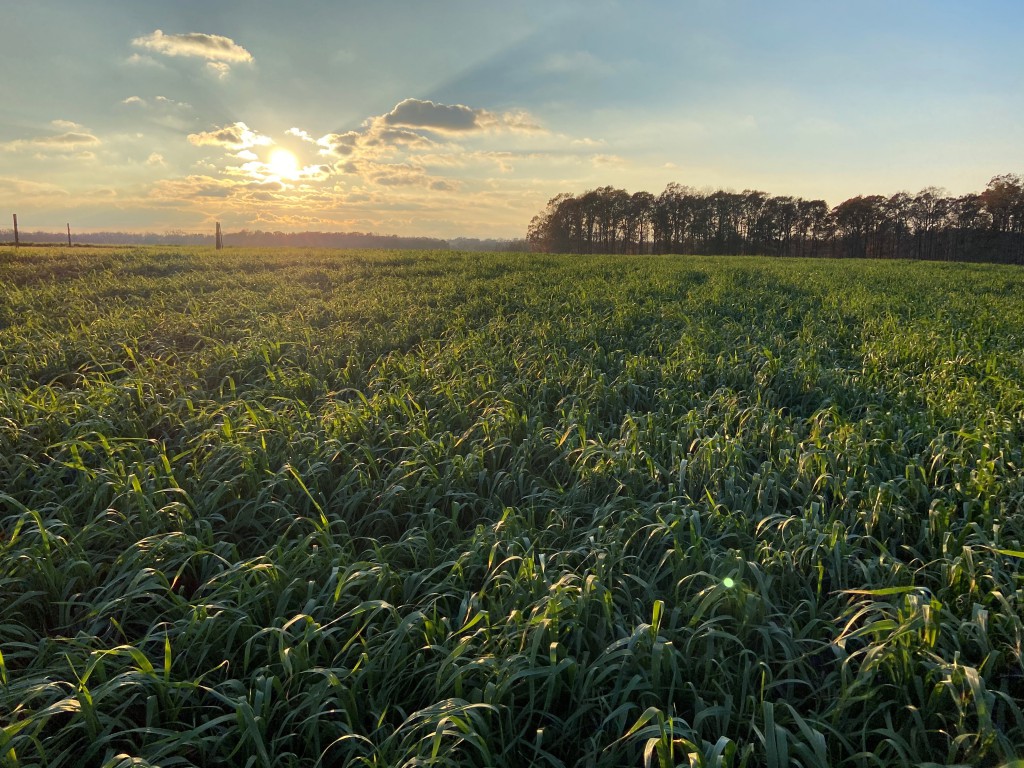It seems like every summer I get calls from hay producers and cattlemen worried that a lack of timely rain or over-fertilization will cause their forage to be high in nitrates. Every winter I get calls from producers with dead cattle or late term abortions, that are worried that the hay they are feeding is the cause of these issues. So what are nitrates? Why are they dangerous? And what can we do about them?
Nearly all forages contain some level of nitrates. When feeds containing nitrates are consumed by ruminants, the nitrates are converted to nitrites and finally to ammonia by microbes in the rumen. Nitrites is one of the intermediate products in the breakdown of nitrate to ammonia and is what causes poisoning in livestock. Nitrite, when it enters the bloodstream, changes hemoglobin to methemoglobin. Hemoglobin carries oxygen from lungs to the rest of the body. Methemoglobin is not able to carry oxygen. Therefore, if enough methemoglobin is produced, the animal effectively smothers due to lack of oxygen. One of the tell-tale symptoms of nitrate poisoning is chocolate-colored blood, due to the lack of hemoglobin. Other signs are rapid breathing, muscle tremors, incoordination, diarrhea, frequent urination, abortion and death. Interestingly enough, ruminant animals are the ones severely affected by high nitrates in forages. Non-ruminant herbivores, like horses, have a digestive system that handles increased nitrate levels much better than their ruminant counterparts.
So what causes high nitrates in forages? Several management and weather factors play into this. Since plants use nitrate for growth, young plants take up nitrates and utilize them fairly quickly. As plant growth slows, the plant continues to take up nitrates but does not convert it to protein as readily. This can cause a buildup of nitrates in the plant. Periods of drought or prolonged bouts of cloudy weather are often associated with slowed plant growth and the accumulation of nitrates. Plants take up nitrogen quickly after a drought ending rain in an effort to grow, also. So expect nitrates to be high for approximately a week after the pasture or hayfield has gotten adequate rainfall. Anything that is stressful for the plant, and delays growth, can cause an increase in nitrates. Some herbicide applications can also increase nitrate accumulations.

Some forage species are more commonly associated with accumulation of nitrates. Particularly, sorghum and sudangrasses store high amounts of nitrates. Millet can have the same issues if cut at the wrong time. Certain weeds, like pigweed, and lambsquarter are typically high in nitrates during normal growing conditions, and can quickly accumulate dangerous levels under stressful conditions. Large applications of nitrogen fertilizer, followed by insufficient rainfall, are one of the most common causes of high nitrates in hay production. Ensiling tends to reduce the nitrate content of forages, but it is not a magic bullet. Forages high in nitrate can lose from 40-60 percent of their nitrate content during fermentation. Keep in mind that fermentation normally takes at least 3 weeks.
As a producer, what can you do to manage high nitrates in your forage? One of the easiest, is to split the nitrogen applications on pastures and hayfields. It is more beneficial from a nitrate standpoint, as well as a financial standpoint. Weather is not a factor that we can control. But we can be smart about putting out nitrogen in front of a rain, or using irrigation if it’s available. Is a forage that can accumulate nitrates is the right fit for your operation? Test your forages! If you are worried about high nitrate levels, call your County Agent for a forage sample. I can promise that the cost of the test is less than a dead cow. If you do end up with higher than ideal nitrate levels, dilute that high nitrate forage with one with an acceptable level. For example, if feeding hay, put out both low and high nitrate forage in order to diffuse the effects. Don’t strip graze high nitrate pastures.
Don’t turn hungry animals into high nitrate pastures or feed hungry animals high nitrate hay. This ensures that they won’t gorge themselves on something that is harmful to them. Also, in some instances, if cattle can adjust to feeds that have potentially toxic levels of nitrates, they will develop a population of microbes in the rumen that convert nitrates to a non-toxic form. Don’t graze suspected high nitrate pastures for about a week after a killing frost.
So what are high levels of nitrates? Typically, we advise folks to start being careful at levels above 4500ppm. 4500-6500 ppm can be safe under must conditions, but if feeding pregnant animals, it should be limited to half of the ration. 6500-9000 ppm should be limited to one half of the ration, regardless of the class of animal. If your forage has over 9000 ppm of nitrates, contact your county agent to discuss your feeding situation. There is some evidence that horses can tolerate up to 10,000 ppm nitrate concentrations easily. Also, be aware that not every lab reports nitrates in the same manner. For example, the Clemson University Forage Lab measure units of nitrate-nitrogen and the University of Georgia Forage Lab measures nitrates. To convert nitrate-nitrogen to nitrates, multiple the nitrate nitrogen by 4.426. So if looking at reports from different labs, make sure to compare apples to apples.
Nitrate toxicity in any type of livestock can be frightening. But with a little effort and planning, it doesn’t have to be an issue on your operation.